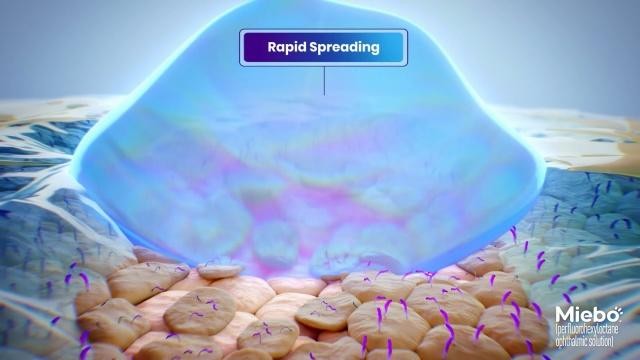Miebo, a revolutionary eye drop for dry eye disease, boasts a hefty price tag. Why is this innovative treatment so expensive? This article delves into the factors contributing to Miebo’s high cost, examining its unique formulation, clinical effectiveness, and insurance coverage.
 Miebo action on the eye's surface
Miebo action on the eye's surface
Understanding Miebo: A Unique Approach to Dry Eye
Miebo stands out from conventional dry eye treatments due to its unique composition and mechanism of action. Unlike traditional artificial tears that primarily address tear volume deficiency, Miebo targets the root cause of evaporative dry eye – a deficient lipid layer.
This lipid layer, a thin oily film on the tear surface, prevents rapid tear evaporation. Miebo, formulated with perfluorohexyloctane (PFHO), a synthetic lipid, replenishes this crucial layer. PFHO’s rapid spreading and lubricating properties provide immediate relief from dryness, grittiness, and burning sensations.
Clinical Effectiveness and Long-Term Benefits
Extensive clinical trials have demonstrated Miebo’s efficacy in treating dry eye disease. Studies show significant improvements in corneal healing within two weeks, with continued progress observed after two months of consistent use. A longer-term study, spanning 52 weeks, confirmed substantial improvement in both signs and symptoms of dry eye with four-times-daily application. These positive results underscore Miebo’s long-term benefits, potentially justifying its higher cost compared to temporary relief offered by other options.
Preservative-Free Formulation: A Factor in Cost
Miebo’s preservative-free formulation contributes to its cost. Preservatives, commonly used in eye drops to extend shelf life, can irritate sensitive eyes and exacerbate dry eye symptoms in some individuals. Miebo’s 100% PFHO composition eliminates the need for preservatives, ensuring greater tolerability and minimizing potential side effects. This specialized formulation necessitates advanced manufacturing processes and stricter quality control, impacting the overall cost.
Small Drop Size, Maximum Effectiveness
Miebo’s uniquely small drop size (10-12 microliters compared to the typical 50 microliters) also plays a role in its pricing. This precise dosage minimizes waste, ensuring that more of the medication reaches the ocular surface, enhancing effectiveness and potentially reducing the frequency of application. This specialized packaging and delivery system likely contribute to the higher manufacturing cost.
Meibomian Gland Penetration: A Unique Advantage
Miebo’s ability to penetrate the meibomian glands, responsible for producing the oily component of tears, further distinguishes it from other treatments. This unique characteristic can potentially improve the function of these glands, addressing the underlying cause of evaporative dry eye in some patients. This innovative mechanism of action, backed by scientific research, contributes to Miebo’s premium pricing.
Insurance Coverage and Out-of-Pocket Expenses
Miebo is a prescription medication, and its cost is often mitigated by insurance coverage. While the average monthly price without insurance can be substantial (around $925), insurance plans significantly reduce out-of-pocket expenses. Programs like BlinkRx offer discounts and even a free first bottle, bringing the monthly cost down to around $60 with insurance. However, individual insurance plans vary, and it’s crucial to verify coverage and co-pay costs with your provider.
Conclusion: Weighing Cost Against Benefits
Miebo’s high cost reflects its unique formulation, proven clinical effectiveness, and potential long-term benefits in managing dry eye disease. While the price may seem daunting without insurance, coverage options often make it more affordable. Ultimately, the decision to use Miebo should be made in consultation with an eye care professional, weighing the cost against the potential for lasting relief from debilitating dry eye symptoms. If you’re struggling with dry eye, discuss Miebo with your doctor to determine if it’s the right solution for you.
